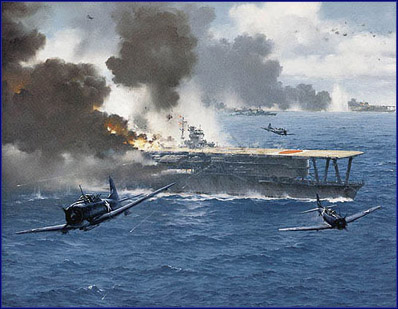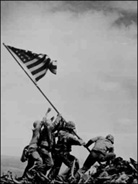



THE PACIFIC WAR
The Pacific War Historical Society presents an illustrated history of the Pacific War from Pearl Harbor to Guadalcanal
Text and Web-site by James Bowen. Web-site established May 2002 and last updated 23 November 2009
![]()
![]()
![]()
MIDWAY - THE BATTLE THAT TURNED THE TIDE OF THE PACIFIC WAR

"THE FAMOUS FOUR MINUTES" - by R.G. Smith *
This painting depicts one of the defining moments of the Pacific War when the tide turned against the Japanese aggressors at America's Midway Islands. Lieutenant Richard Best and his two wingmen in their Douglas Dauntless SBD dive-bombers have just launched a successful attack on the Japanese flagship aircraft carrier Akagi. The crushing defeat inflicted on the Japanese Navy by the very much smaller United States Pacific Fleet at Midway put an end to Japan's ambition to dominate the central Pacific region, and removed the Japanese threat to Hawaii.
![]()
![]()
![]()
On 7 December 1941, the Japanese launched a devastating surprise attack on the United States Pacific Fleet at its Pearl Harbor base in Hawaii. The attack was not preceded by a declaration of war, and took place while Japanese diplomats were in Washington discussing American concerns about continuing Japanese military aggression in East Asia. These diplomatic discussions were intended by the Japanese to distract the attention of Americans while Japan secretly positioned a powerful aircraft carrier striking force off the Hawaiian islands. About nine hours later, the Japanese struck at American military forces in the Philippines. Despite that nine hour notice, the American army commander in the Philippines, General Douglas MacArthur, had failed to place his air force and troops on a war footing, and American air power in the Far East was destroyed by the Japanese on the ground.
While the Japanese Imperial Navy was striking at Pearl Harbor, Japanese troops were invading British Malaya and being resisted by British, Australian and Indian forces. On 23 January 1942, Japanese troops landed at Rabaul in the Australian Territory of New Guinea and overwhelmed the heavily outnumbered Australian garrison. When Singapore fell to the Japanese on 15 February 1942, the British government was not prepared to assist Australia to resist a Japanese invasion, preferring instead to allocate all available British and Australian military resources to the defence of India. The British Government even resisted the return of Australian troops from the Middle East to defend their own country.
Having been abandoned by Britain to a likely Japanese invasion, Australia turned to the United States for help, and it was generously given. Thereafter, the Americans and Australians fought together as allies to stem, and ultimately repel the Japanese military onslaught.
This web-site is one of two linked web-sites that trace the history of Japanese military aggression in the Pacific War. At the Pacific War and Battle for Australia web-sites, the viewer is taken from Pearl Harbor to the great naval Battle of Midway that destroyed Japanese naval supremacy over the United States and marked the turning of the tide against Japan in the Pacific War. The viewer will then be taken to the Kokoda and Guadalcanal Campaigns that brought Japanese military aggression to a halt in the South-West Pacific, and forced Japan on the defensive.
The Pacific War Web-site is dedicated to the courageous Americans and Australians who fought together to defeat the Japanese military onslaught that began at Pearl Harbor on 7 December 1941 and ended at Tokyo Bay on 2 September 1945.

In this famous Pacific War image, marines raise the American flag on Iwo Jima
|
PACIFIC
WAR BRIEFING NOTES |
|
INTERACTIVE PACIFIC WAR BATTLE ANIMATIONS A new Pacific War web-site featuring interactive animations of key Pacific War battles, including Coral Sea, Midway, and Guadalcanal is now online. These excellent animations should assist viewers to follow text descriptions of very complex battles such as Midway and Coral Sea. Strongly recommended. |
|
NEW PACIFIC WAR BOOKS Black
Shoe Carrier Admiral: Frank Jack Fletcher at Coral, Sea, Midway and Guadalcanal |
The FULL SITE INDEX may be accessed from the "ENTER" button below. For faster access to major Pacific War topic headings visitors may wish to try this Index:
PEARL HARBOR--- THE BATTLE OF THE PHILIPPINES--THE BATTLE FOR AUSTRALIA--BOLD AMERICAN COUNTER-ATTACKS --THE AMERICAN AND JAPANESE NAVAL AIR SERVICES--THE BATTLE OF THE CORAL SEA -- THE BATTLE OF MIDWAY --THE KOKODA CAMPAIGN--GUADALCANAL--JAPANESE WAR CRIMES 1937-45--ATOMIC BOMBING OF JAPAN-
For the convenience of visitors, this web-site provides a "GOOGLE" search facility below the full site index.
All of several hundred links on this web-site are examined at least once every fourteen days for breaks. If a link is found to be broken, visitors are invited to try an indirect approach to the specific object of their search such as the powerful Google search engine which can be accessed at the end of the main index to this web-site. If this approach fails, visitors are invited to return after the expiration of two weeks. The web-master apologises for any inconvenience caused by a broken link.
WOULD YOU LIKE TO CONTACT THE AUTHOR/WEBMASTER?
The author/webmaster may be contacted by electronic mail at:
![]()
Any inconvenience caused by removal of the author/webmaster's previous hot-linked address is regretted.The previous hot-linked address produced a continuing flood of unsolicited junk mail, or "spam".
MORE WEB-SITES FOR THE HISTORY ENTHUSIAST
THE HISTORY RING
|